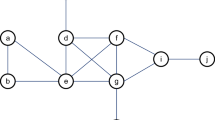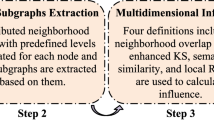Abstract
Node importance identification is a crucial content in studying the substantial information and the inherent behaviors of complex network. On the basis of topological characteristics of nodes in complex network, we introduce the idea of topology potential from data field theory to capture the important nodes and view it as the skeleton nodes. Inspired by an assumption that different mass of node (\( m_{j} \) parameter) reflects different quality and interaction reliability over the network space. We propose TP-KS method that is an improved topology potential algorithm whose \( m_{j} \) is identified by k-shell centrality. The important nodes identified by TP-KS is ranked and verified by SIR epidemic spreading model. Through the theoretical and experimental analysis, it is proved that TP-KS can effectively extract the importance of nodes in complex network. The better results from TP-KS are also confirmed in both real-world networks and artificial random scale-free networks.
Access this chapter
Tax calculation will be finalised at checkout
Purchases are for personal use only
Similar content being viewed by others
References
Li, D., Wang, S., Li, D.: Spatial Data Mining. Theory and Application. Springer, Heidelberg (2015). https://doi.org/10.1007/978-3-662-48538-5
Grady, D., Thiemann, C., Brockmann, D.: Robust classification of salient links in complex networks. Nat. Commun. 3(1), 864 (2012)
Kumari, T., Gupta, A., Dixit, A.: Comparative study of page rank and weighted page rank algorithm, vol. 2, no. 2, p. 9 (2007)
Zhang, D., Gao, L.: Virtual network mapping through locality-aware topological potential and influence node ranking. Chin. J. Electron. 23(1), 61–64 (2014)
Wang, Y., Yang, J., Zhang, J., Zhang, J., Song, H., Li, Z.: A method of social network node preference evaluation based on the topology potential, pp. 223–230 (2015)
Sun, R., Luo, W.: Using topological potential method to evaluate node importance in public opinion. In: Presented at the 2017 International Conference on Electronic Industry and Automation, EIA 2017 (2017)
Han, Q., Wen, H., Ren, M., Wu, B., Li, S.: A topological potential weighted community-based recommendation trust model for P2P networks. Peer-Peer Netw. Appl. 8(6), 1048–1058 (2015)
Lei, X., Zhang, Y., Cheng, S., Wu, F.-X., Pedrycz, W.: Topology potential based seed-growth method to identify protein complexes on dynamic PPI data. Inf. Sci. 425, 140–153 (2018)
Ding, X., Wang, Z., Chen, S., Huang, Y.: Community-based collaborative filtering recommendation algorithm. Int. J. Hybrid Inf. Technol. 8(2), 149–158 (2015)
Han, Q., et al.: A P2P recommended trust nodes selection algorithm based on topological potential. In: 2013 IEEE Conference on Communications and Network Security, CNS, pp. 395–396 (2013)
Wang, Z., Zhao, Y., Chen, Z., Niu, Q.: An improved topology-potential-based community detection algorithm for complex network. Sci. World J. 2014, 1–7 (2014)
Wang, S., Gan, W., Li, D., Li, D.: Data field for hierarchical clustering. Int. J. Data Warehouse. Min. 7(4), 43–63 (2011)
Han, Y., Li, D., Wang, T.: Identifying different community members in complex networks based on topology potential. Front. Comput. Sci. China 5(1), 87–99 (2011)
Xiao, L., Wang, S., Li, J.: Discovering community membership in biological networks with node topology potential. In: 2012 IEEE International Conference on Granular Computing, GrC, pp. 541–546 (2012)
Kitsak, M., et al.: Identification of influential spreaders in complex networks. Nat. Phys. 6(11), 888–893 (2010)
Network data. http://www-personal.umich.edu/~mejn/netdata/. Accessed 14 May 2018
Alex Arenas datasets. http://deim.urv.cat/~alexandre.arenas/data/welcome.htm. Accessed 14 May 2018
Tang, Y., Li, M., Wang, J., Pan, Y., Wu, F.-X.: CytoNCA: a cytoscape plugin for centrality analysis and evaluation of protein interaction networks. Biosystems 127, 67–72 (2015)
Lawyer, G.: Understanding the influence of all nodes in a network. Scientific reports, vol. 5, no. 1, August 2015
Kendall, M.G.: THE treatment of ties in ranking problems. Biometrika 33(3), 239–251 (1945)
Ma, L.-L., Ma, C., Zhang, H.-F., Wang, B.-H.: Identifying influential spreaders in complex networks based on gravity formula. Phys. Stat. Mech. Appl. 451, 205–212 (2016)
Liu, J., Xiong, Q., Shi, W., Shi, X., Wang, K.: Evaluating the importance of nodes in complex networks. Phys. Stat. Mech. Appl. 452, 209–219 (2016)
Wang, J., Li, M., Wang, H., Pan, Y.: Identification of essential proteins based on edge clustering coefficient. IEEE/ACM Trans. Comput. Biol. Bioinform. 9(4), 1070–1080 (2012)
Li, M., Wang, J., Chen, X., Wang, H., Pan, Y.: A local average connectivity-based method for identifying essential proteins from the network level. Comput. Biol. Chem. 35(3), 143–150 (2011)
Anthonisse, J.M.: The rush in a directed graph, January 1971
Sabidussi, G.: The centrality index of a graph. Psychometrika 31(4), 581–603 (1966)
Tang, L., Liu, H.: Community detection and mining in social media. Synth. Lect. Data Min. Knowl. Discov. 2(1), 1–137 (2010)
Bonacich, P.: Power and centrality: a family of measures. Am. J. Sociol. 92(5), 1170–1182 (1987)
Estrada, E., Hatano, N.: Resistance distance, information centrality, node vulnerability and vibrations in complex networks. In: Estrada, E., Fox, M., Higham, D.J., Oppo, G.-L. (eds.) Network Science, pp. 13–29. Springer, London, London (2010). https://doi.org/10.1007/978-1-84996-396-1_2
Estrada, E., Rodríguez-Velázquez, J.A.: Subgraph centrality in complex networks. Phys. Rev. E 71(5), 056103 (2005)
Acknowledgement
This work was supported by the National Key Research and Development Program of China (No. 2016YFB0502600), The National Natural Science Fund of China (61472039), Beijing Institute of Technology International Cooperation Project (GZ2016085103), and Open Fund of Key Laboratory for National Geographic Census and Monitoring, National Administration of Surveying, Mapping and Geoinformation (2017NGCMZD03).
Author information
Authors and Affiliations
Corresponding author
Editor information
Editors and Affiliations
Rights and permissions
Copyright information
© 2018 Springer Nature Switzerland AG
About this paper
Cite this paper
Yuan, H., Malang, K., Lv, Y., Phaphuangwittayakul, A. (2018). From Complex Network to Skeleton: \( \varvec{m}_{\varvec{j}} \)-Modified Topology Potential for Node Importance Identification. In: Gan, G., Li, B., Li, X., Wang, S. (eds) Advanced Data Mining and Applications. ADMA 2018. Lecture Notes in Computer Science(), vol 11323. Springer, Cham. https://doi.org/10.1007/978-3-030-05090-0_35
Download citation
DOI: https://doi.org/10.1007/978-3-030-05090-0_35
Published:
Publisher Name: Springer, Cham
Print ISBN: 978-3-030-05089-4
Online ISBN: 978-3-030-05090-0
eBook Packages: Computer ScienceComputer Science (R0)




